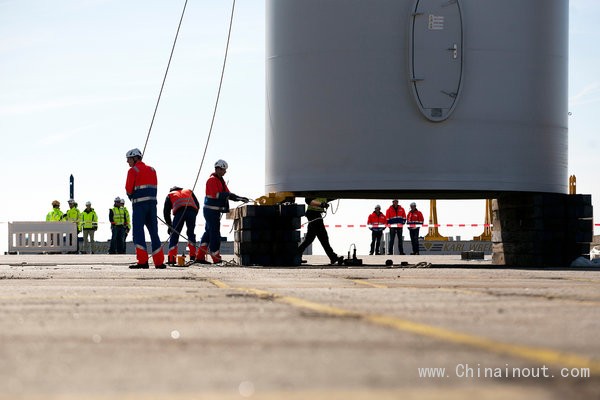德國黑爾戈蘭島——幾乎沒有哪個發(fā)達國家會像德國這般賣力地尋求全球變暖的解決之道。現(xiàn)在,,一些高聳的大家伙作為這項努力的象征,出現(xiàn)在了北海中。
它們是風力渦輪機,,屹立在距內陸60英里的地方,足有60層樓那么高,,每臺耗資達3000萬美元,。這些機器都是龐然大物,有的光是上邊的一個葉片,,大小就和天空中最大的客機——空客A380——差不多了,。今年年底前,數(shù)十臺新安裝的渦輪機會給向南數(shù)百英里處的德國城市供應清潔電能,。
這將是德國耗資巨大的電力系統(tǒng)改造工程的又一個里程碑,。此項宏大的工程已經取得了驚人的成效:可再生能源對該國電力供應的貢獻率很快就能達到30%。這對很多小國而言可能不在話下,,但迄今為止,,德國是近現(xiàn)代達到這一水平的工業(yè)國中最大的一個。30%的比例較美國高出一倍多,。
德國在不斷地推進可再生能源的開發(fā)利用,,其影響遠遠超出了它的國界。通過催生出對風力渦輪機和太陽能板(尤其是后者)的巨大需求,,它在將中國大型制造企業(yè)吸引到這個市場的過程中發(fā)揮了作用,,由此產生的合力正讓成本飛速下降——幾年前根本沒人料到會降得如此之快。
全球的電力公司高管們,,眼睜睜看著一度被自己視作無關緊要的技術開始威脅到自家公司長期以來的經營方略,,無不如坐針氈。美國各地都爆發(fā)了有關可再生能源電力未來規(guī)則的討論,。許多曾打算通過建造燃煤發(fā)電廠來為國民供電的窮國,,眼下正探討是否可以跳過化石燃料時代,從一開始就構建清潔能源網絡,。
清算的時刻到了,,而德國的情況可能比任何地方都要明了。幾乎每個月,,德國都會刷新可再生能源電力的生產紀錄,,但與此同時,這些變化讓該國的公用事業(yè)公司損失慘重,來自電力生產的利潤一路狂跌,。
類似的情況很可能出現(xiàn)在其他那些正推行宏大的可再生能源規(guī)劃的國家,。美國的一些州對華盛頓的立法僵局失去了耐心,已經自行設立了雄心勃勃的目標:在2020年之前就要讓可再生能源對電力供應的貢獻率達到20%至30%,。
德國人把自己的方案叫“能源轉型”(energiewende),,這個詞已經開始被其他國家和地區(qū)的一些人掛在嘴邊。德國被全世界奉為楷模,,環(huán)保人士常常以它為例來證明,,全球能源系統(tǒng)的轉型是可以實現(xiàn)的,。
但人們越來越清楚地看到,,這種轉型即便可行,也會是一個痛苦的過程,。一些業(yè)內人士稱,,電力產業(yè)進入了它130年的歷史上最激烈的動蕩期,它正迎來一場裂變,,其影響可能堪比航空,、音樂以及電話產業(yè)曾經發(fā)生的那些重塑產業(yè)格局的大裂變。
行業(yè)觀察人士表示,,要充分利用這種可能性,,也許就得拋開電力市場的舊有規(guī)則,重新規(guī)劃——大概還得作一些安排,,比如向公用事業(yè)公司額外付費,,讓其保留傳統(tǒng)發(fā)電廠備用,以應付風力和日照不足的情況,。德國政府已經認識到了啟用新規(guī)則的必要性,,盡管它還沒弄清新規(guī)則該是什么樣。美國的少數(shù)幾個州同樣在重新思考本州電力系統(tǒng)的運行方式,。
“正在發(fā)生的一切真的十分驚人,,”在柏林做德國能源項目的愛爾蘭投資人杰拉德·里德(Gerard Reid)說,“德國人稱之為轉型,,但在我看來這是一場革命,。”
如果能正確地創(chuàng)建新規(guī)則,就有機會獲得巨大的回報:有一個更為環(huán)保的,、不再向大氣中排放那么多溫室氣體以及其他污染物的電力系統(tǒng),。不過德國的經驗表明,轉型的困難同樣是巨大的,;而且目前還遠遠不能確定該系統(tǒng)的轉型速度是否能快到足以防止全球變暖達到危險的程度,。
“我相信,風和陽光將會成為主要的能量來源,不光在德國,,在全世界都是如此,。”致力于能源轉型研究的柏林智庫阿哥拉能源轉型(Agora Energiewende)的負責人帕特里克·格賴興(Patrick Graichen)說,“問題是:我們怎樣才能讓這場能源轉型成為成功的范例,。”
暴跌的價格
不久前的一天,,在加利福尼亞州明媚的陽光下,工人們手拿嗡嗡作響的電鋸,,給寬敞的新房加上最后的點綴,。這些新房坐落在洛杉磯以南的奧蘭治縣,看起來跟當?shù)氐钠渌课輿]有太大差別,,但它們都有一個附加特性:萊納公司(Lennar Corporation)給自己蓋的每一棟房子都安裝了太陽能面板,。
過去五年,太陽能板的價格大跌了70%,。這種暴跌意味著用太陽能供電開始變得更加經濟了,,尤其是在美國一部分電價較高的地區(qū)。
在加利福尼亞州約100個由萊納公司興建的住宅小區(qū)里,,買家搬進新房時,,就自動獲得了屋頂?shù)奶柲馨濉W鳛槊绹诙笞≌ㄖ痰娜R納公司,,最近決定從科羅拉多州開始,,在其他幾個州推廣這種做法。該公司通常會保留這些組件的所有權,,并和房主簽定為期20年的合同,,讓他們買下產自自家屋頂?shù)碾娏Γ瑑r格比當?shù)毓檬聵I(yè)公司的報價低20%,。
這個太陽能計劃由萊納事業(yè)部(Lennar Ventures)負責,,其總裁大衛(wèi)·J·凱澤曼(David J. Kaiserman)說,“當我們告訴客戶‘包你省錢'時,,事情就變得非常簡單了,。”
在很大程度上,這種經濟性變化是中國——在德國帶動之下——發(fā)揮作用的結果,。過去10年間,,德國人讓一度不成規(guī)模的可再生能源電力市場實現(xiàn)了快速增長,從而降低了走綠色之路的成本,。
德國已經在其能源轉型方案上投入了1400多億美元,,并以固定收益誘惑有意安裝太陽能板、風力渦輪機,、沼氣池等可再生能源設備的農民,、屋主,、企業(yè)以及當?shù)氐暮献魃纭T摲桨傅某杀疽ㄟ^征收可再生能源電價附加費來彌補,,一個普通德國家庭每年大約要繳納280美元,,不過,由于可再生能源拉低了躉售電價,,此項開支被抵消了一部分,。
德國的這一方案幫助擴大了可再生能源市場的規(guī)模,帶來了巨大的規(guī)模效應——過去10年,,太陽能板的全球銷量每隔21個月就會翻倍,,而銷量每翻倍一次,價格就會降低20%左右,。“德國人投入重金,,買的不是電,而是價格的下降,。”舊金山一家能源智庫的負責人哈爾·哈維(Hal Harvey)說,。
在這種連鎖反應下,,美國的一些生產商被迫關門歇業(yè),,中國政府向占據(jù)了很大一部分市場份額的本國廠商發(fā)放補貼之舉,引人抱怨,。不過,,價格的下降也為美國的屋主以及萊納這樣的公司帶來了機會。
近年來,,風電價格也大幅下降,。目前,風電在成本上可以和美國部分地區(qū)新建的燃煤電廠匹敵,。
企業(yè)面臨的威脅
可再生電力成本的下降,,對電力生產企業(yè)構成了威脅。讓這些企業(yè)大賺特賺的,,是一天當中電力需求大,、電價也隨之升高的時段。而太陽能就算規(guī)模不大,,也有可能給市場帶來極大的沖擊,,把用電高峰期的躉售電價拉下來。
盡管光電產業(yè)發(fā)展得很快,,但光電產量在美國電力總產量中所占的比重還不到1%,,因此美國市場尚未受到大規(guī)模的沖擊。不過,,有的公用事業(yè)公司擔心自己因電源結構的變化而遭受損失,,已經開始攻擊那些鼓勵使用太陽能面板的規(guī)則了。另外一些公司則采取了相反的策略,干脆投身到了光電市場之中,。
緊隨這些公用事業(yè)公司之后的,,是高速成長的初創(chuàng)公司,它們正把數(shù)以萬計的太陽能板安在人們的屋頂上,,并和屋主簽下無需付押金的租約,,為其提供資金支持的是華爾街的銀行機構。加利福尼亞州被卷入了這股熱潮之中,,該州計劃在2020年之前把可再生能源電力上網比重提高到33%,,現(xiàn)在看來,實現(xiàn)這一目標的可能性正逐步加大,。
在德國,,太陽能面板和風力渦輪機的發(fā)電量分別占總發(fā)電量的7%和10%,一度最有利可圖的用電高峰期的躉售電價已經大幅下降,。公用事業(yè)巨頭萊茵集團(RWE)的首席執(zhí)行官彼得˙特里烏姆(Peter Terium)于今年春天宣布該集團虧損了38億美元時承認:“我們進入可再生能源市場的時間有些晚——也許是太晚了,。”
德國的這些大型公用事業(yè)公司提醒說——也許可以稱之為懇求——這場革命要想進行下去,就得帶上它們,。外部專家稱,,他們的話或許有點道理。
可再生能源有一個致命的弱點,,即供電的間歇性,。因此,德國的公用事業(yè)公司不得不通過迅速調高或調低傳統(tǒng)發(fā)電廠的發(fā)電量來保持供需平衡,。以這種方式運營的傳統(tǒng)發(fā)電廠未必有利可圖,,公用事業(yè)公司一直揚言要關閉這些電廠,但有分析人士認為德國需要用它們來應對不時之需,。
由于德國政府決意放棄核能,,情況變得越發(fā)復雜。2011年日本福島核泄漏事故發(fā)生后,,在德國存在已久的核電站存廢之爭終于有了結果:該國政府宣布將用10年時間關閉國內的核電站,。隨著這一計劃的實施,清潔電能的一個來源將被切斷,,德國在溫室氣體減排方面取得的令人矚目的成績已經停滯不前,。
事實上,能源轉型帶來的問題在過去幾年里迅速增多,,以致于德國政府正竭力放緩轉型的腳步,。“我認為我們還需要一點點時間,”德國環(huán)境部副部長約亨·弗拉斯巴斯(Jochen Flasbarth)說,。
技術創(chuàng)新
可再生能源開始讓電力供給和價格產生波動之際,,有專家認為,,如果新建立的市場規(guī)則足夠明智,應該可以把成本控制在合理范圍內,。
他們所推薦的一些新制度,,在某種程度上已經得到了應用——這些制度是由美國率先實施的,德國正在積極研究,。其中包括定期付費給公用事業(yè)公司,,令其保留一些化石燃料發(fā)電廠,在可再生能源短缺時作應急之用,。
“就好比你向你的律師支付聘金,,以確保她在你需要的時候一定會出現(xiàn),”卡內基梅隆大學(Carnegie Mellon University)的電力專家杰伊·阿普特(Jay Apt)說,。
對德國人而言,,由于內陸地區(qū)可再生能源電力的產量存在不可預測性,海風的吸引力便顯現(xiàn)了出來,。北海和波羅的海上空的風力強大而穩(wěn)定,,意味著安裝在那里的渦輪機在發(fā)電量上遠遠高于內陸地區(qū)的渦輪機。
正因為如此,,三家公用事業(yè)公司差不多算是把黑爾戈蘭島給占領了,,直接與這個度假小島上的一家酒店簽下了10年的租約。它們正按照長期規(guī)劃建設風電場,,一直要建到距海岸125英里遠的地方,,而黑爾戈蘭島是最適合用來做行動基地的一片陸地。
小島的街道上擠滿了待遇優(yōu)厚的工人,。“真的,黑爾戈蘭島每個地塊都在獲益,,”當?shù)匾患壹媸蹜敉庥闷返募佑驼镜慕浝戆送?middot;倫達(Eike Walenda)說,。
當然了,海上風電場的建設費用遠高于陸地上的費用,。每臺渦輪機高達3000萬美元的身價不僅僅是機器本身的價格,,還包含了電纜費、安裝費等好多項費用,。為了吸引公用事業(yè)公司參與這樣的項目,,德國政府不得不答應它們把電價提高到市價的好幾倍。
不過,,德國人預計在未來10年里,,海風發(fā)電的成本可以隨著市場規(guī)模的增長而大幅下降——就像早期的那些可再生能源發(fā)電技術那樣。要是成本真降下來,,美國也許會成為受益者,。有研究表明,,海風發(fā)電可為東海岸城市供應其所需電量的15%至20%;而且美國的幾個項目很快就要開工建設了,。
德國消費者已經為太陽能板,、內陸地區(qū)的風力渦輪機、沼氣池,,以及向可再生能源時代過渡所需的其他一切承擔了高昂的成本,,現(xiàn)在,他們又要因海風電場而多承擔數(shù)十億美元,。民意調查顯示,,他們樂意擔起這副擔子。
“事實上,,德國民眾正付出高昂的代價,,”能源智庫阿哥拉能源轉型的分析師馬庫斯·施泰根貝格爾(Markus Steigenberger)說,“但在德國,,我們能夠承擔得起——我們是富裕國家,。這是我們給世界的禮物。”(中國進出口網)
HELIGOLAND, Germany — Of all the developed nations, few have pushed harder than Germany to find a solution to global warming. And towering symbols of that drive are appearing in the middle of the North Sea.
They are wind turbines, standing as far as 60 miles from the mainland, stretching as high as 60-story buildings and costing up to $30 million apiece. On some of these giant machines, a single blade roughly equals the wingspan of the largest airliner in the sky, the Airbus A380. By year's end, scores of new turbines will be sending low-emission electricity to German cities hundreds of miles to the south.
It will be another milestone in Germany's costly attempt to remake its electricity system, an ambitious project that has already produced striking results: Germans will soon be getting 30 percent of their power from renewable energy sources. Many smaller countries are beating that, but Germany is by far the largest industrial power to reach that level in the modern era. It is more than twice the percentage in the United States.

Germany's relentless push into renewable energy has implications far beyond its shores. By creating huge demand for wind turbines and especially for solar panels, it has helped lure big Chinese manufacturers into the market, and that combination is driving down costs faster than almost anyone thought possible just a few years ago.
Electric utility executives all over the world are watching nervously as technologies they once dismissed as irrelevant begin to threaten their long-established business plans. Fights are erupting across the United States over the future rules for renewable power. Many poor countries, once intent on building coal-fired power plants to bring electricity to their people, are discussing whether they might leapfrog the fossil age and build clean grids from the outset.
A reckoning is at hand, and nowher is that clearer than in Germany. Even as the country sets records nearly every month for renewable power production, the changes have devastated its utility companies, whose profits from power generation have collapsed.
A similar pattern may well play out in other countries that are pursuing ambitious plans for renewable energy. Some American states, impatient with legislative gridlock in Washington, have set aggressive goals of their own, aiming for 20 or 30 percent renewable energy as soon as 2020.
The word the Germans use for their plan is starting to make its way into conversations elsewher: energiewende, the energy transition. Worldwide, Germany is being held up as a model, cited by environmental activists as proof that a transformation of the global energy system is possible.
But it is becoming clear that the transformation, if plausible, will be wrenching. Some experts say the electricity business is entering a period of turmoil beyond anything in its 130-year history, a disruption potentially as great as those that have remade the airlines, the music industry and the telephone business.
Taking full advantage of the possibilities may require scrapping the old rules of electricity markets and starting over, industry observers say — perhaps with techniques like paying utilities extra to keep conventional power plants on standby for times when the wind is not blowing and the sun is not shining. The German government has acknowledged the need for new rules, though it has yet to figure out what they should be. A handful of American states are beginning a similar reconsideration of how their electric systems operate.
"It's pretty amazing what's happening, really," said Gerard Reid, an Irish financier working in Berlin on German energy projects. "The Germans call it a transformation, but to me it's a revolution."
The potential payoff for getting the new rules right is enormous: a far greener electricity system that does not pump as much greenhouse gas and other pollution into the atmosphere. Yet as the German experience shows, the difficulties of the transition are likely to be enormous, too, and it is still far from clear whether the system can be transformed fast enough to head off dangerous levels of global warming.
"I am convinced that wind and sun will be the central sources of energy, not only in Germany but worldwide," said Patrick Graichen, who heads a think tank in Berlin, Agora Energiewende, devoted to studying the shift. "The question is: How can we turn the energy transition into a success story?"
Plummeting Prices
One recent day, under a brilliant California sun, saws buzzed as workers put the finishing touches on spacious new homes. They looked like many others going up in Orange County, south of Los Angeles, but with an extra feature: Lennar Corporation was putting solar panels on every house it built.
The prices of the panels have plunged 70 percent in the past five years. That huge decline means solar power is starting to make more economic sense, especially in parts of the United States with high electricity prices.
At about 100 Lennar subdivisions in California, buyers who move into a new home automatically get solar panels on the roof. Lennar, the nation's second-largest homebuilder, recently decided to expand that policy to several more states, starting with Colorado. The company typically retains ownership of the panels and signs 20-year deals to sell homeowners the power from their own roofs, at a 20 percent discount from the local utility's prices.
"It's so simple when we tell a customer, 'You're guaranteed to save money,' " said David J. Kaiserman, president of Lennar Ventures, the division overseeing the solar plan.
The shifting economics can largely be traced to China, by way of Germany. Over the past decade, the Germans set out to lower the cost of going green by creating rapid growth in the once-tiny market for renewable power.
Germany has spent more than $140 billion on its program, dangling guaranteed returns for farmers, homeowners, businesses and local cooperatives willing to install solar panels, wind turbines, biogas plants and other sources of renewable energy. The plan is paid for through surcharges on electricity bills that cost the typical German family roughly $280 a year, though some of that has been offset as renewables have pushed down wholesale electricity prices.
The program has expanded the renewables market and created huge economies of scale, with worldwide sales of solar panels doubling about every 21 months over the past decade, and prices falling roughly 20 percent with each doubling. "The Germans were not really buying power — they were buying price decline," said Hal Harvey, who heads an energy think tank in San Francisco.
The ripple effects drove some American panel manufacturers out of business, prompting complaints about Chinese government subsidies to the manufacturers who seized much of the market. But the decline also created an opportunity for American homeowners and for companies like Lennar.
Wind power, too, has come down sharply in price in recent years, and it is now competitive with the cost of new coal-burning power plants in parts of the United States.
A Threat to Business
The decline in the cost of renewable power spells potential trouble for companies that generate electricity. They make a lot of their money at times of day when demand for power, and therefore power prices, are high. Solar power, even a small amount, could be especially disruptive, shaving wholesale prices during those peak periods.
Though growing rapidly, solar power still accounts for less than 1 percent of American power generation, so the disruption has not yet been seen on a large scale in the United States. But some utilities, fearful of losing out as the power mix changes, have started attacking rules that encourage solar panels. Others are taking the opposite tack, jumping into the solar market themselves.
Nipping at the heels of those utilities are fast-growing start-up companies that are putting tens of thousands of panels on rooftops and leasing them to homeowners for no money down, with Wall Street banks providing the financing. The hot spot is California, which is aiming for 33 percent renewable power by 2020 and seems increasingly likely to get there.
In Germany, wher solar panels supply 7 percent of power and wind turbines about 10 percent, wholesale power prices have crashed during what were once the most profitable times of day. "We were late entering into the renewables market — possibly too late," Peter Terium, chief executive of the giant utility RWE, admitted this spring as he announced a $3.8 billion annual loss.
The big German utilities are warning — or pleading, perhaps — that the revolution cannot be allowed to go forward without them. And outside experts say they may have a point.
The Achilles' heel of renewable power is that it is intermittent, so German utilities have had to dial their conventional power plants up and down rapidly to compensate. The plants are not necessarily profitable when operated this way, and the utilities have been threatening to shut down facilities that some analysts say the country needs as backup.
The situation is further complicated by the government's determination to get rid of Germany's nuclear power stations over the next decade, the culmination of a long battle that reached its peak after the 2011 Fukushima disaster in Japan. As that plan unfolds, shutting down a source of low-emission power, Germany's notable success in cutting greenhouse gases has stalled.
In fact, the problems with the energiewende (pronounced in-ur-GEE-vend-uh) have multiplied so rapidly in the past couple of years that the government is now trying to slow down the transition. "I think we need a little bit of time," said Jochen Flasbarth, a deputy minister of the environment.
Technological Innovation
As renewable energy sources start to cause gyrations in power supplies and prices, experts contend that clever new market rules could keep the costs reasonable.
Some of the innovations they recommend are already in use to some extent — pioneered in the United States, with Germany avidly studying them. They include regular payments to persuade utilities to keep some fossil-fuel power plants on standby for times when renewable sources lag.
"It's like a retainer you pay your lawyer to keep her around in case you need her," said Jay Apt, an electricity expert at Carnegie Mellon University.
For Germans, the unpredictability of onshore renewable power explains the appeal of offshore wind. The stiff, steady breezes in the North Sea and the Baltic Sea mean that turbines built there will produce far more power than land turbines.
That is why three utilities have virtually seized control of the tiny resort island of Heligoland, renting out one hotel for 10 years straight. It is the most convenient body of land to use as an operations base for the huge wind farms they are installing, with long-range plans to go as far as 125 miles offshore.
The streets of the island are thronged with well-paid workers. "Really, all areas on Heligoland are profiting," declared Eike Walenda, the manager of a local outfitter and fueling station.
The costs of building in the sea are far higher than on land, of course. The price tag of up to $30 million per turbine is not just for the machine itself, but also for power cables, installation and many other items. To induce utilities to go forward, the government has had to guarantee them power prices of several times the market rate.
But, just as with earlier forms of renewable technology, the Germans expect the costs of harnessing offshore wind to dro sharply as the market grows over the coming decade. If that happens, the United States could be a big beneficiary. Studies have shown that offshore wind could supply as much as 15 to 20 percent of the power needed by East Coast cities, and construction is about to start on a handful of American projects.
For now, the German offshore farms are adding billions to the costs consumers are already bearing for solar panels, onshore wind turbines, biogas plants and the rest of the transition to renewable energy. Polls suggest it is a burden they are willing to carry.
"Indeed, the German people are paying significant money," said Markus Steigenberger, an analyst at Agora, the think tank. "But in Germany, we can afford this — we are a rich country. It's a gift to the world."











